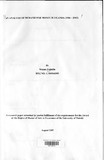| dc.description.abstract | A stable money demand function is the essence of planning and implementing monetary
policy. The main purpose of this paper is to Estimate Uganda's money demand function
and to find out whether there exists a stable money demand function in Uganda. This
study presents both a descriptive and empirical analysis of money demand in Uganda
over the period 1986:1-2003:4. It also reviews some basic concepts of money demand
theory, summarizes the results of developed and developing countries' studies that have
used partial adjustment model (PAM), Co-integration and/or error correction techniques
and reviews model specification issues. The study makes use of an expanded model
incorporating institutional variables in addition to the normally used (traditional)
variables. Two definitions of money (M1/P and M2/P) were used and they exhibited a
general upward trend for the most of the period under study. In addition, the study tests
for the existence of co-integration between monetary aggregates and real money
balances.
Following the existence of co-integration, error-correction models were built for the two
money demand functions namely real Narrow Money (M1/P) and real Broad money
(M2/P) demand. From our results, income (GDP) in the two Money demand functions
was found to be positively related to money demand and not significantly different from
unity which implied that for the period, increases in income led to an increase in real cash
balance. Money demand was also found to be negatively related to exchange rate and
interest rate in the two functions, suggesting that there is a degree of substitution from
non-interest bearing Ugandan notes into interest bearing financial assets and into
holdings of foreign currency. Also inflation was found to be negatively related to the
money demand functions. Financial innovation was found to have a negative effect on
M1/P and M2/P. The Money demand functions remained stable for the entire period, as
confirmed by the chow tests, forecast statistics and the recursive graphics. The empirical
findings conclude that the demand for money in Uganda is stable. | en |

